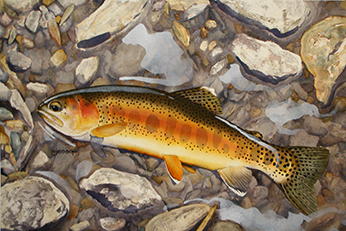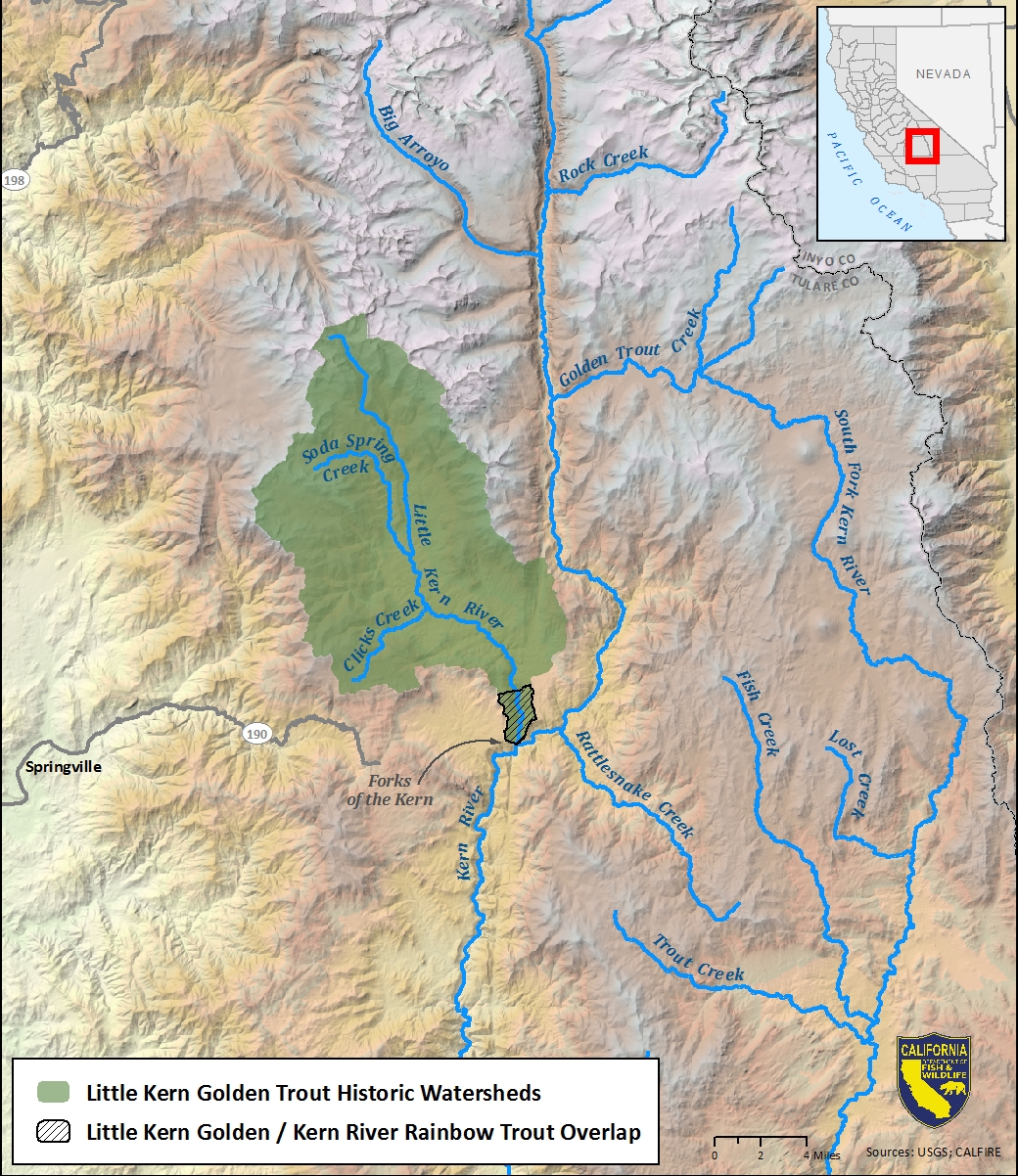Oncorhynchus aguabonita whitei
Distribution and Habitat
 © Mark Jessop, all rights reserved.
© Mark Jessop, all rights reserved.
 Little Kern golden trout historic watershed. (click/tap to enlarge)
Little Kern golden trout historic watershed. (click/tap to enlarge)
Little Kern golden trout are native to the Little Kern River and tributaries in the southern Sierra Nevada (Tulare County), mostly within Sequoia National Forest and Sequoia National Park. The Little Kern River is a tributary to the Kern River. These trout have been isolated from more recent invasions of coastal rainbow trout by a series of impassable waterfalls created by mountain uplift in the lower portion of the drainage. Transplants drastically altered the distribution of Little Kern golden trout. Early anglers and ranchers moved fish to waters outside their historic range, such as Coyote Creek in the 1880s. Later transplants of non-native trout into the Little Kern River basin displaced the subspecies from much of its historic habitat through competition and hybridization.
Due to considerable conservation and restoration efforts, genetically pure populations are currently found in a majority of the tributaries within the Little Kern basin. Secure pure populations are located upstream of barriers that provide protection from non-native trout. Other streams within the drainage have populations with relatively low levels of introgression.
Threats
The introduction of non-native rainbow trout into the Little Kern River basin is the principal threat to Little Kern golden trout.
Conservation and Management
Many projects have been implemented to conserve and restore Little Kern golden trout to their historic habitat within the Little Kern River basin, spanning a number of decades. After hatchery trout stocking into the Little Kern River watershed was stopped, CDFW began surveys to determine if any “pure” populations remained. Based on external characteristics and a uniform appearance, the fish in upper Soda Spring Creek were believed to be the principal remaining pure population. Efforts were undertaken to expand this population.
Further surveys and genetic analyses began in the early 1970s to better understand the distribution of remaining genetically “pure” Little Kern golden trout. Artificial barriers were constructed during this time to establish refuge areas within the Little Kern River basin. These barriers were built to protect existing populations in the tributaries and to create new habitat where non-native fish could be removed and pure trout restored. Chemical treatments to remove non-native trout occurred at multiple locations throughout the basin from the mid-1970s through mid-1980s. A Fishery Management Plan for the Little Kern golden trout was written in 1978 and a revised version was adopted in 1984. Critical habitat was defined and conservation measures developed to restore populations to levels that will merit delisting under the Federal Endangered Species Act.
In spite of past chemical treatments, introgressed populations still exist in the main-stem Little Kern River and some tributaries, although levels of introgression are relatively low. The 2011 Lion Fire burned much of the Little Kern River basin, including several streams with key conservation populations of Little Kern golden trout. In 2012, CDFW, in collaboration with the U.S. Forest Service (Sequoia National Forest) and U.S. Fish and Wildlife Service, implemented a comprehensive basin-wide assessment to evaluate population status, habitat condition, and barrier integrity. Tissue samples were collected throughout the basin for an updated genetic analysis. Results from this study will provide updates to the Fishery Management Plan and help prioritize future restoration and recovery actions.
Species Status
Little Kern golden trout are a threatened species under the Federal Endangered Species Act.